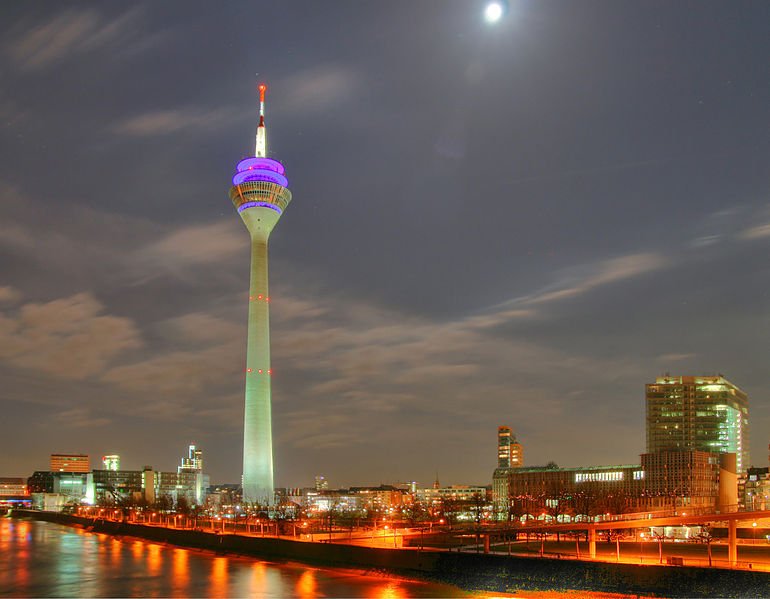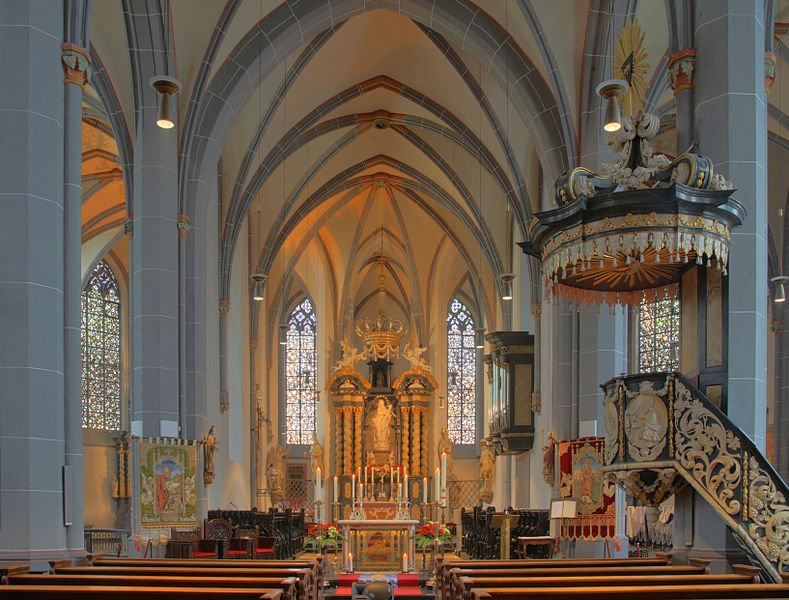 Neuer Zollhof, Düsseldorf
Neuer Zollhof, DüsseldorfSource: https://en.wikipedia.org/wiki/File:D%C3%BCsseldorf,_Medienhafen.jpg
Author: Filippo

Düsseldorf is the state capital of North Rhine-Westphalia, Germany. This city at the heart of the Rhine-Ruhr metropolitan region covers 217 sq km (84 sq mi) and has a population of 589,000 (2011 estimate) within a metropolitan area with some 7.3 million inhabitants.
Düsseldorf is a business and financial center for the Ruhr region. It is also renowned as an exhibition and trade fair venue. Messe Düsseldorf holds some 20% of all the major trade shows in the world.
 View of Rheinturm in Düsseldorf at night
View of Rheinturm in Düsseldorf at nightSource: https://commons.wikimedia.org/wiki/File:Duesseldorf_Rheinturm_Medienhafen.jpg
Author: Till Niermann

Düsseldorf is located at the center of the Lower Rhine basin, through which the Düssel River flows into the Rhine. The land here comprises alluvium, mud, sand, clay and gravel. The highest point in the city is the 165-meter (541-ft) Sandberg.
The warmest months in Düsseldorf are July and August, with average high temperatures of 22°C (72°F). Coldest months are January and February, with average lows of 0°C (32°F). June is the wettest month with 96.5 mm (3.799 in) of precipitation.
Düsseldorf traces its roots to Germanic settlements on the eastern banks of the Rhine River, at the confluence with the Düssel River. It was first mentioned in AD 1135, where it was called Dusseldorp. The town was ruled by the Dukes of Berg from 1186. A power struggle pitted the Count of Berg against the Archbishop of Cologne in the Battle of Worringen in 1288. The defeat of Cologne paved the way for Düsseldorf to be given city status, but it soured relationship with Cologne, and long-standing rivalry between the two cities have remained since.
 St Lambertus Church, Düsseldorf
St Lambertus Church, DüsseldorfSource: https://commons.wikimedia.org/wiki/File:St_Lambertus_Duesseldorf_1.jpg
Author: till.niermann

Düsseldorf went through a patch of hard times following the Napoleonic Wars. Napoleon made Berg a Grand Duch with Düsseldorf serving as its capital. After Napoleon was defeated, the entire Rhineland including Berg became part of the Kingdom of Prussia in 1815.
The Industrial Revolution gave a new lease of life to Düsseldorf, which doubled its population between 1882 and 1892. The city was heavily bombarded by the Royal Air Force during the Second World War as it targeted German oil facilities, much of which are located in the Düsseldorf area.
Following the war, Düsseldorf was made the capital of the newly created federal state of North Rhine-Westphalia. During the period of reconstruction, it transformed into a developed city centered on trade, administration and service industries.
 Andreaskirche in Düsseldorf-Altstadt
Andreaskirche in Düsseldorf-AltstadtSource: https://commons.wikimedia.org/wiki/File:St._Andreas_Duesseldorf_10.jpg
Author: Velopilger

Visiting Düsseldorf, Germany
Düsseldorf International Airport (DUS) is presently the third largest airport in Germany, receiving flights from 175 destinations worldwide. Arriving at the airport, you can take the subway trains S7 and S11 to reach the Düsseldorf Railway Station in the city center. The fare for the 12-minute journey is €2.20. The same journey by taxi will set you back €22.00.Other airports in the vicinity include the Cologne-Bonn Airport (CGN) and Weeze Airport (NRN). Arriving at Weeze Airport, 80 km from downtown Düsseldorf, you can catch a bus that takes you to the Düsseldorf Railway Station. It takes an hour and the fare is €13.00.
 Düsseldorf Rathaus (Old Town Hall)
Düsseldorf Rathaus (Old Town Hall)Source: https://commons.wikimedia.org/wiki/File:D%C3%BCsseldorf_%28DerHexer%29_2010-08-13_083.jpg
Author: DerHexer

Places of Interest in Düsseldorf
- Altstadt
The Old Town of Düsseldorf was severely devastated during the Second World War. Some of the buildings that have been restored include its townhouses and the Gothic-style Rathaus (town hall). - Heinrich-Heine-Institut
Institute established to preserve and celebrate the works of the namesake German poet. - Hetjens-Museum
This is the oldest museum in Germany devoted to ceramics. It is housed in the Nesselrode Palace. - Hofgarten
Park laid out in 1769 by Elector Karl Theodor in the style of an English garden. - Kaiserswerth
A neighborhood of Düsseldorf with its Romanesque parish church of St. Suitbertus. - Königsallee
The "king's alley" is an upscale shopping avenue along the old city moat. It boasts some of the most luxurious stores in Düsseldorf. - Kunstsammlung Nordrhein-Westfalen
The state art collection showcasing works by 20th century artists. - Museum Kunst PalastThis is one of the most interesting art museums in Germany, with collection spanning the 16th to the 20th century.
- Neanderthal
Valley near the towns of Erkrath and Mettman, some 12 km from Düsseldorf, where remains of pre-historic men, the Neanderthal, was first discovered. - Neuer Zollhof
Cutting-edge architecture of American architect Frank O. Gehry in Düsseldorf. - Pfarrkirche St. Andreas
The Parish Church of St. Andrew dates from 1622. It has a ducal mausoleum complex behind the presbytery. - Rheinturm
The 240-meter Rhine Tower is beside the River Rhine. It has a restaurant at 172-meters high offering 360° views. - Schloss Benrath
This is a charming Neo-Classical hunting palace built by the electors of the Palatine in 1755-73. - Schlossturm
The castle tower, the only remaining part of Düsseldorf Castle, is now a museum of navigation. - St. Lambertus Basilica
The former collegiate church of St Lambertus was first erected in 1288. It has important furnishings including the Gothic sacramentarium and Gothic ducal tombs.
 Latest updates on Penang Travel Tips
Latest updates on Penang Travel Tips
About this website

Thanks for reading this page. My name is Timothy Tye. My hobby is to research information about places, and share the information with people on this website. I started this website on 5 January 2003, and since then, have written about over 20,000 places, mostly in Malaysia and Singapore.
Please use the information on this page as guidance only. While I try my best to provide you information that is as accurate as I can get it to be, I do apologize for any errors. Also, as I might not be able to update some information on time, some of these pages may contain outdated information.
Copyright © 2003-2024 Timothy Tye. All Rights Reserved.


 Go Back
Go Back